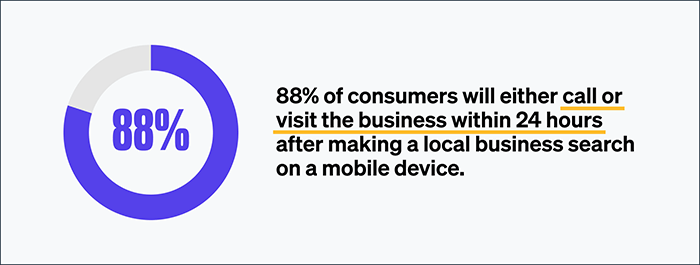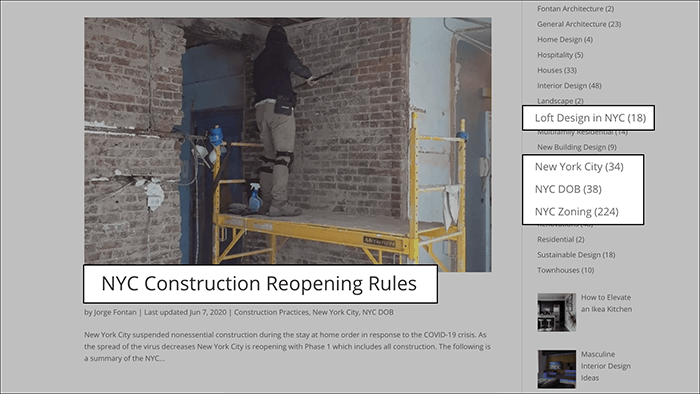Contents
Today I’m going to show you how to rank your architecture practice for local search terms.
So if you want to:
- Get more traffic to your website
- Generate more leads organically
- Sign on more clients in your local area
Then you’ll love this new guide.
Let’s dive right in.
What is Local SEO?
Local SEO is the optimization of your online presence to attract more traffic, leads, and sales from relevant local searches.
In the Architect's Guide to SEO, we talk about best practices on general SEO, but in this article, we’ll go more deep dive into Local SEO especially.
Why Architects Need Local SEO
First, the stats say it all:
Nearly half (46%) of all Google searches have local intent (Search Engine Roundtable).

88% of consumers will either call or visit the business within 24 hours after making a local business search on a mobile device (SEO Tribunal).

A whopping 97% of people find out about a local company online (SEO Tribunal).

Many small architecture firms rely heavily on local businesses.
But winning more local projects depends on having a strong marketing strategy in place, and the core of this should be local SEO.
With an effective local SEO strategy, your architecture firm will be more visible in search giving you a big advantage over your competitors.
You can be more visible, generate more traffic to your website, and attract more prospective clients.
Pretty nice, huh?
Exactly how should you get started with local SEO for architects?
Here are several key strategies that make up an effective local SEO strategy.
1 - Get Your Website in Order
The first thing you need when devising a strong local SEO strategy is a website that’s optimized for SEO.
That means:
- being mobile optimized (which should go without saying these days)
- fast to load (a fast web host will help)
- providing a good user experience
- and having intuitive navigation
Taking website speed, for example, not only is it a direct ranking factor, but it also indirectly affects your rank by increasing bounce rates.
The most straightforward way to see how fast your pages load is Google PageSpeed Insights. You can use it to test the speed of your website.

Yes, there’s a lot to do to correctly optimize your website for SEO, but it’s the foundation of any successful SEO strategy, local or otherwise.
A good website will not be enough to get your site ranking on its own, but it is necessary. You may want to hire a professional web designer to get it into shape.
2 - Set Up Your Google My Business Page
Apart from your website, the foundation of your local SEO strategy should be your Google My Business page. This is absolutely vital for any local business that wants to be found in search.
According to Moz, the #1 ranking factor for ranking in local search is your Google My Business page.

What is Google My Business
Google My Business is a business listing that allows you to create a business profile for free. But it also gives you a stronger presence in both Google Search and Google Maps.

Think of it as a second website, and use it to provide information about your business including opening hours, contact information, photos, videos, customer reviews, and more.
The Local 3 Pack
The Local 3 Pack is a search engine feature that is displayed like a map and shows places related to your search.
Essentially, if your business is listed in the search results “3-Pack,” you are listed in the block of three local listings at the top of the search results.
And this, for a local business, is where the money is. If your architecture website is not in 3-pack, you’re giving money to your competitors.

When people click on your listing, they will see your location on the map as well as your Google My Business information and a link to your website.
3 - Get More Customer Reviews
Everyone wants happy customers. Not only do they mean repeat business, but they can also encourage new customers to give you a try.
In fact, studies show that nearly 3/4 of happy customers will share their positive feedback with 6 or more people.
Positive reviews provide social proof, and they can help to build trust in your business.
73% of consumers trust a business after seeing that it has positive reviews (SEO Tribunal).

But there’s more. Positive reviews are also considered to be a factor in search ranking and can therefore help you to get more visibility in local search.
Simply put, it’s a good idea to encourage customers to leave reviews on your Google My Business page as well as other third-party review sites.
Don’t forget to reply to reviews as well. Interacting and responding to reviews will also help your SEO and improve your position in the search engines.

4 - Build Local Citations
Local citations refer to mentions of your business on other websites. Citations are thought to be an important factor in local SEO, even if they may be less important now than they were in the past. They essentially help search engines to verify your business.
There are 2 types of citations:
- Structured citations include the NAP, which stands for Name, Address, and Phone Number of your business.
- Unstructured citations are more contextual and consist of more general mentions, perhaps in a blog post.
You should aim to get a mix of the two, especially on local sites and big sites like Yelp, Apple Maps, YellowPages, and Facebook. They will also appear naturally over time (especially unstructured citations).

You can also get citations on sites more closely related to your architecture business like Houzz and HomeAdvisor.

5 - Carry Out Local Keyword Research
Keyword research is one of the most important parts of any SEO strategy. You want to find out which search terms your potential customers are using when they are looking for local architects.
Local intent keywords are important for local SEO, and they could include your town, city, specific neighborhood, or state.
This can be quite a large task, but it’s well worth doing, and you may want to hire an SEO specialist to help you. If not, you might want to use a dedicated paid keyword research tool like SEMRush or Ahrefs.

You can also get ideas from free tools like Google Trends or by checking the “Related Searches” in the standard Google search results.

There may be many keywords that you have not thought of, which could potentially drive a lot of traffic. You may end up with a long list of long-tail keywords, which are made up of many words, as well as question-based keywords.
6 - Use Your Local Keywords on Your Pages
Once you have carried out your keyword research, you should have a list of the most important keywords andd use these in your content.
This means incorporating them into the main pages like your homepage and service pages as well as using them in the right places like the title tags, URL, and alt text. The FAQ page is a good place to add question-based keywords.

Just using keywords will not be enough on its own to get your site ranking, and you should avoid going over the top. However, it is still an important factor to consider when it comes to local SEO for architects.
7 - Launch a Blog
Another important place to use your keywords is in the company blog. Publishing a regular blog remains an important factor in SEO because it allows you to add content regularly to refresh your website, provide valuable information to build trust, and make use of long-tail keywords that might be harder to use on your main pages.
You could publish blog posts on recent projects, interviews with industry experts, client testimonials, and important developments in your local area.

You might publish a guide to hiring an architect and use it to fit in lots of long-tail keywords around the topic that would not fit naturally in your service pages.
You should also consider posting about things that are relevant to your customers—which means local issues. This is a great way to get local intent keywords into your content including road names, local parks, areas of your town or city, and local landmarks.
8 - Build Links to Your Website
Backlinks are an important ranking signal for local SEO, and if you post content that has value, it’s easier to get links. A detailed guide to hiring an architect, for example, could generate links naturally.
Here are some ways to get links back to your website:
- Ask your customer to link to your website in blog posts about recent projects you completed for them.
- Approach your Local Chamber of Commerce or ask your local township websites to add your business in a local listing.

- Collaborate with other local businesses that are related to your field to link to each other.
- Offer guest posts for other businesses like local travel websites. You can post about types of local architecture and link back to your website.
- Do Pro-bono projects with local charities or sponsor them so your website shows up on their project pages.

Building links is an ongoing task. The more links you can get from authoritative websites, the higher you are likely to rank in the search results.
9 - Share Your Content on Social Media
Another good thing about a blog is that you can share your posts on social media. Having a strong social media presence is becoming increasingly important, and it is a great way to build trust in your business.
You could create an Instagram account and make it focused on your local area, posting regularly about local issues, especially those relating to architecture, buildings, and planning.

This is a great way to get more visibility in your local area, and it’s also a good way to get your content shared—which can lead to more links to your website and help with your local SEO efforts.
Boost Your Local SEO Strategy Today
Now, it’s over to you.
Which strategy from today’s post are you going to try today?
Are you already using any of these tips?
Either way, these SEO tips are designed to be easy to implement and effective at ranking your architect business for local search terms.




